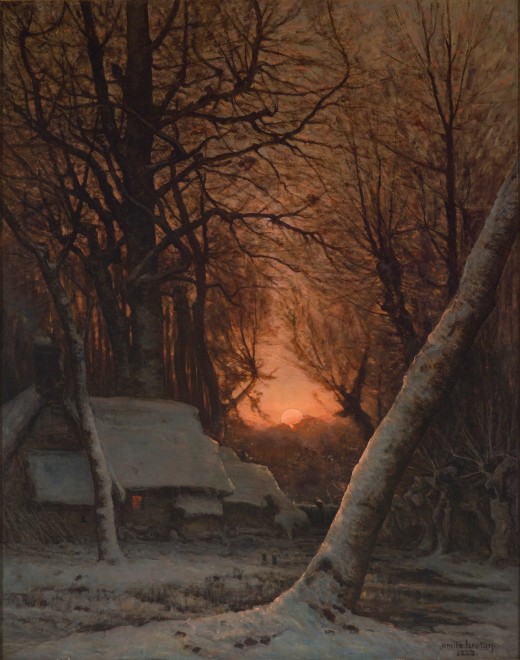Exhibited
Salon, Paris, Palais des Champs-Elysées, 1888, no. 372
Catalogue note
Émile Breton’s painting captures the serene beauty of a winter evening, where the fading light of day casts a tranquil yet melancholic atmosphere over a snow-covered forest. The scene is bathed in the soft orange glow of a setting sun, its warm hues creating a stunning contrast against the cool, icy tones of the snow and trees. Towering, bare branches of high-rising trees frame the composition, their dark silhouettes stretching toward the sky. The forest, silent and still, seems to hold its breath in the twilight.
In the center of the piece, the sun itself glows with a rich orange hue, its last rays spilling across the horizon before the inevitable onset of night. The sun’s vivid light serves as the focal point, drawing the viewer’s gaze toward the heart of the scene. It is a fleeting moment, suspended between day and night, evoking both beauty and a sense of impermanence.
Nestled in the foreground, a quaint, snow-covered house stands quietly, its roof blanketed in fresh white. A subtle glow emanates from the window of the house, a delicate warmth piercing the chill of the surrounding winter landscape. The faint light suggests the presence of life within, offering a sense of comfort and refuge amid the cold, desolate forest.
For Breton, whose work was deeply shaped by personal loss and the turbulence of his time, nature became both a subject and a mirror for his own emotional experiences. His landscapes often captured the fragility of life, where the transition from day to night, or the subtle warmth of light against cold surroundings, symbolized the passage of time and the quiet moments of introspection. This painting, with its quiet beauty and emotional depth, reflects the intimate connection Breton had with both nature and his own inner world.
This note was written by Elsa Dikkes.

